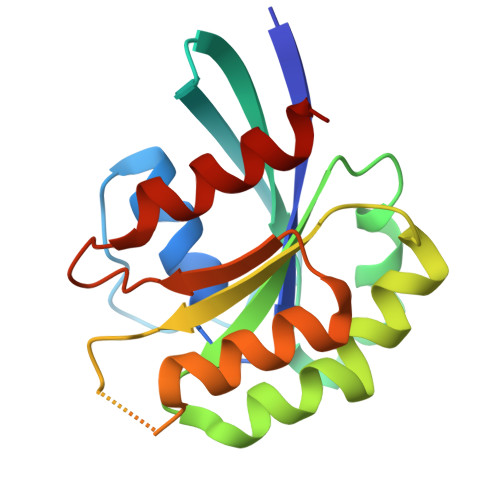Structural insights into the binding of nanobody Rh57 to active RhoA-GTP.
Zhang, Y., Cheng, S., Zhong, P., Wang, Z., Liu, R., Ding, Y.(2022) Biochem Biophys Res Commun 616: 122-128
- PubMed: 35665664
- DOI: https://doi.org/10.1016/j.bbrc.2022.05.084
- Primary Citation of Related Structures:
7XQV - PubMed Abstract:
RhoA protein is a small GTPase that acts as a molecular switch. When bound to guanosine triphosphate (GTP), RhoA can activate several key signal pathways. Recently, nanobody Rh57 specific binding with GTP bound active RhoA was discovered and developed as a BRET biosensor without cytotoxicity. To further clarify the nanobody Rh57's mechanism of action, we co-expressed, purified, and crystallized the RhoA-Rh57 nanobody complex and solved the structure by X-ray diffraction with a resolution of 2.76 Å. The structure showed that the interaction is mainly through hydrogen bonds, salt bridges, aromatic-aromatic interactions, and hydrophobic interactions. The involved regions include CDR3 and non-hypervariable loop of Rh57, and the SWI switch loops of RhoA, respectively. The different SWI conformation of inactivated RhoA-GDP prevented the Rh57's binding. The possible explanation of Rh57 as a non-cytotoxic BRET intracellular tracer is that Rh57's binding did not overlap with downstream PRK1 and thus did not interfere with the downstream signaling pathway. Our research provides an in-depth understanding of how nanobodies recognize activated RhoA-GTP while not binding inactivated RhoA-GDP. This structural information may also provide critical information for further optimization of relevant nanobodies.
- State Key Laboratory of Genetic Engineering, School of Life Sciences, Fudan University, Shanghai, 200438, China.
Organizational Affiliation:




















